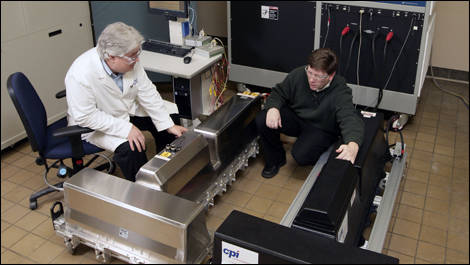Ever since Bob Lutz made that promise, every environmentalist has been waiting for General Motors to make the next step. Now, the American auto giant doesn't have much of a choice: it has to come to market with the revolutionary Chevrolet Volt, a long-range electric car expected by 2010.
Of course, there are many skeptics who question the feasibility of this project. After looking at the production schedule, a Japanese competitor even claimed it was impossible. "If it were, they'd be deciding on the type of wood trim to put inside by now," we were told.
Such claim puts a laughing smile on the face of Frank Weber, the Volt Project Manager at GM. "The thing is, this car won't have any wood trim," he said.
Granted, it's the widespread skepticism that led GM to organize a guided tour of its facilities with some fifty journalists, most of them being environmental experts and technology specialists from all over the world. Right off the bat, GM confirmed its plans to produce the Chevrolet Volt.
"This project is our number one priority here at GM. What we've done up to this point, actually, is what you'll see here today. Consider it as a preview picture," explained Mr. Weber.
The number one concern: batteries
Batteries represent the main concern for the Volt. According to GM's wishes, the car will have to become a viable, independent solution for ever-rising oil prices. Energy storage systems are critical, as they must allow a 65-km range in electric mode and be easy to charge for at least 10 years.
"Our biggest challenge is durability, said Denise Gray, Director of Hybrid Energy Storage Systems. We have to make sure that the consumption and charge cycles won't affect the durability of batteries. The process must be quick and highly effective, even though the package is pretty compact. We know that 2010 looms on the horizon. That's why we're accelerating our efforts to achieve this goal."
Right now, two propositions are on the table: one from Continental and A123 Systems, the other from CPI and LG. Both corporate groups were given a T-shaped block (85x163cm) to be filled with lithium-ion batteries so as to meet the needs of the future Volt. The resulting battery pack weighs 180 kilos.
 |
Of course, there are many skeptics who question the feasibility of this project. After looking at the production schedule, a Japanese competitor even claimed it was impossible. "If it were, they'd be deciding on the type of wood trim to put inside by now," we were told.
Such claim puts a laughing smile on the face of Frank Weber, the Volt Project Manager at GM. "The thing is, this car won't have any wood trim," he said.
Granted, it's the widespread skepticism that led GM to organize a guided tour of its facilities with some fifty journalists, most of them being environmental experts and technology specialists from all over the world. Right off the bat, GM confirmed its plans to produce the Chevrolet Volt.
"This project is our number one priority here at GM. What we've done up to this point, actually, is what you'll see here today. Consider it as a preview picture," explained Mr. Weber.
The number one concern: batteries
Batteries represent the main concern for the Volt. According to GM's wishes, the car will have to become a viable, independent solution for ever-rising oil prices. Energy storage systems are critical, as they must allow a 65-km range in electric mode and be easy to charge for at least 10 years.
"Our biggest challenge is durability, said Denise Gray, Director of Hybrid Energy Storage Systems. We have to make sure that the consumption and charge cycles won't affect the durability of batteries. The process must be quick and highly effective, even though the package is pretty compact. We know that 2010 looms on the horizon. That's why we're accelerating our efforts to achieve this goal."
Right now, two propositions are on the table: one from Continental and A123 Systems, the other from CPI and LG. Both corporate groups were given a T-shaped block (85x163cm) to be filled with lithium-ion batteries so as to meet the needs of the future Volt. The resulting battery pack weighs 180 kilos.
 |


